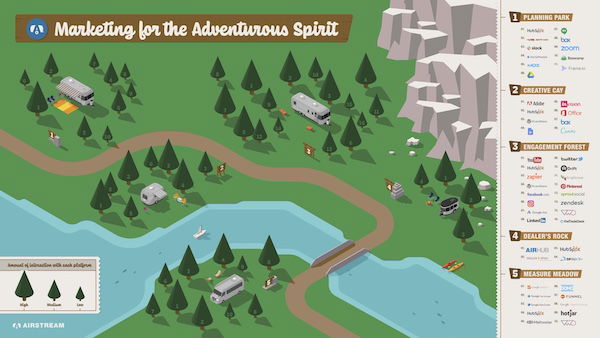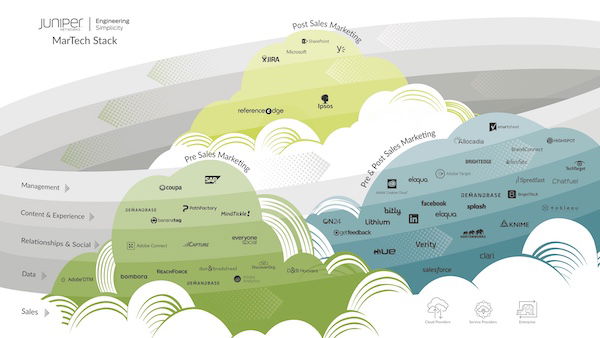
Gartner’s research shows that companies now spend more on marketing technology than on advertising in fact 58% of all B2B marketers plan on using some form of marketing automation technology as four out of five users are seeing an increase in leads. 77% of users are also seeing an increase in conversions. This goes to show just how vital technology has become to the marketing field.
Each business has to assess their MarTech requirements and create a long-term strategy for themselves. Knowing which marketing strategy to pursue and what MarTech stack to employ requires a lot of research. Since no solution fits all, businesses have to create their own unique strategy by taking into consideration their requirements, type of clientele, campaigns they pursue, and the volume.
MarTech trends have evolved over time and this time around, we will show you the MarTech stacks of successful companies and also help you decide on a good MarTech stack for your organization.
What is a MarTech stack?
Marketing relies heavily on technology, and as more tools emerge, this trend will only rise. Marketing technology tools are collectively known as MarTech.
MarTech or marketing technology comprises all the software and technology-based tools that help marketers plan, execute and analyze marketing or promotional campaigns.
These tools may be used to automate marketing processes, collect user data, or even further the reach of businesses. Therefore, the whole range of tools that companies leverage to increase their brand recognition and better their conversion is collectively known as MarTech Stack.
A good MarTech stack addresses the entire marketing cycle; right from the initial stages of attracting the customers to their journey, analysis of marketing campaigns, and more.
Evolution of MarTech Stacks
Marketing technology goes all the way back to the early '90s, wherein Bristol-Myers-Squibb created the first online campaign to market a medicine called Excedrin. Since then, the industry has grown in leaps and bounds as technology progressed. Similarly, Martech stacks also change over time.
The changes that happen are not always additive because certain tools and stacks get redundant and hence are removed or replaced. Stacks are built based on the specific functionality of the tools involved, and over time this functionality might pick up several new dimensions.
For instance, the decisioning category of tools has come a long way from simple Excel software to more complicated tools that make use of Artificial Intelligence and Big Data Analysis.
The entire MarTech ecosystem is evolving as systems, software and services blend into each other. This has led to different growth rates for various categories of tools. Research has shown that over the last three years, tools that help with Data Accumulation and Analysis has grown the most, at over 124%.
The field of Social and Relationships is on the verge of eclipsing Content and Experience and is growing at over 95%. Over the course of the last two years, it has been noticed that Ads and Promotion is the sector that is growing the slowest at a mere 48%. These trends were partly due to the lack of innovation with regards to new tools, and partly because of changes in market trends.
The number of tools in MarTech stacks also seems to be on the rise, and this in most ways aids the growth of the entire ecosystem. As far as the tools are concerned, 8.7% of vendors take up 51% of the market, suggesting tool use disparity. These figures are suggesting a consolidation of stacks, with long tail tools dropping off and short ones going strong.
What tools should your MarTech Stack have?
The MarTech landscape has grown from including merely 150 companies in 2011 to housing over 8,000 companies in 2020. As the MarTech landscape becomes deeper and more complex, there has been a growth in companies that create software to monitor other software. Hence, we have reached a situation wherein we need MarTech tools to manage other Martech tools!
As per Gartner, MarTech takes up 29% of a CMO’s budget, making it a top priority. The categories that need to be focused on are:
- Content marketing
- Paid media management
- Social media marketing
- Decision automation
- Business intelligence
- Campaign optimization
- Personalization
- Data accumulation
- Project management
The advances made in the fields of natural language processing(NLP), machine learning and deep learning have changed the way we function, and in the process, changed the way we should market.
As per 2019 statistics, almost one-third of all searches made on Google, were via assistant devices. Voice searches differ from a traditional search as they give you fewer results. Therefore, SEO strategization has never been more important than now, because being one of the top results now greatly increases your conversion rates.
The inclusion of chatbots in customer service processes has led to lower upkeep costs and higher efficiencies. The global chatbot market has touched $1.2 billion and is witnessing a 24% growth rate. Hence, integrating conversational marketing technology with business has become imperative.
Machine learning nowadays drives data analysis, leading to the delivery of hyper-personalized content. Hence, marketers should look for ways to utilize AI and ML in their MarTech stacks to increase efficiency.
As the attention span of consumers decreases promotional videos will have unprecedented importance. Adding a video to an email boosts CTR by almost 200%, and having promotional videos on landing pages leads to an 80% increase in conversion rates. Therefore, marketers should take care to not fall too far behind and invest in unique campaigns that utilize videos.
Martech stack examples
Some of the most successful companies worldwide have built formidable MarTech stacks. Let’s take a look at their MarTech stacks and learn how to go about building the right Martech for your company.
BlackRock’s Marketing Stack
Blackrock has a diverse stack specializing in various fields such as planning, creation, engagement, dealings, and measurement of data. Here's a look at the major tools they use.
 Image Credits"/>
Image Credits"/>
Airstream’s Marketing Stack
The Martech stack of AirStream is represented by trees - a martech tool in their stack, and the categories are clustered as camping destinations on the map.
 Image Credits"/>
Image Credits"/>
Juniper’s Marketing Stack
Juniper Networks has a layered design that is easy to comprehend but extremely functional. Their marketing cycle is split into three; pre-sales, post-sales, and pre and post-sales marketing. Here’s a look at the major tools they use.
 Image Credits"/>
Image Credits"/>
The challenge is now on modern-day CMO’s as the MarTech landscape continues to expand and evolve.
Growing a business is now intertwined with having or building the right MarTech stack. If the technology used by a company fails to integrate with its business goals, then the company is left without the ability to leverage technology to grow, leaving it miles behind its competitors.
Do you have the right MarTech stack or want help in reviewing your current MarTech stack? Schedule a complimentary meeting with our MarTech experts here to get expert guidance on how to improve your MarTech stack.